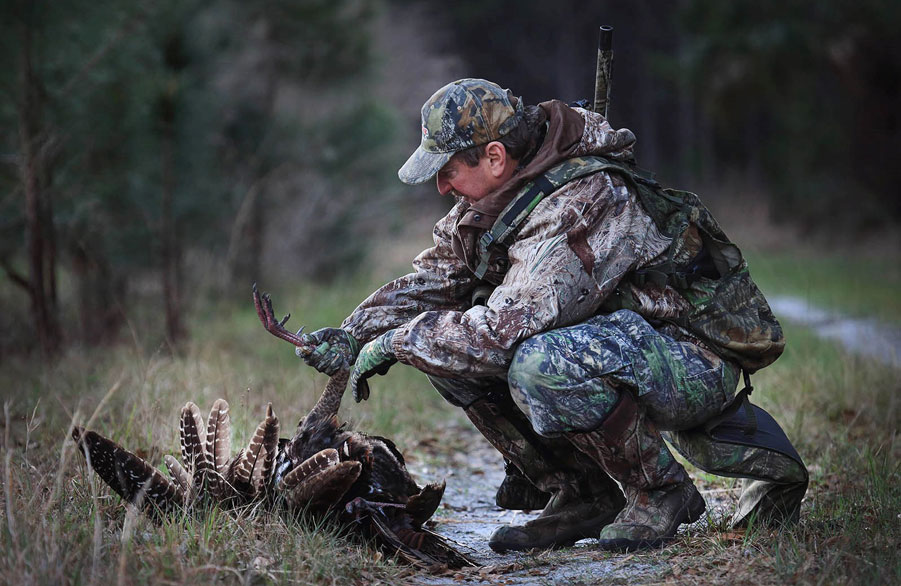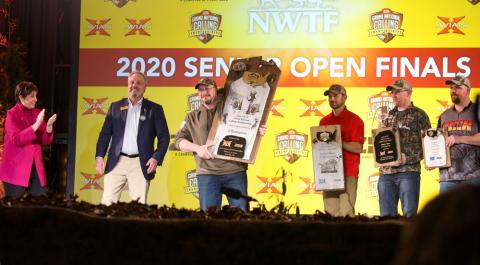provided by John Phillips
Mossy Oak Pro Ron Bachmann of Spring Hill, Florida, is living his dream of hunting and fishing fulltime since his retirement three years ago, after 20 years as a cable-company lineman. He’s been hunting turkeys for 21 years and has been on the Mossy Oak ProStaff for nine years. Florida’s spring turkey season opens at various times, according to where you plan to hunt – private and/or public lands, but Florida always offers the first spring turkey-hunting opportunities in the country. Florida is also the only place in the world where the Osceola subspecies of wild turkey is found, with 80,000-100,000 Osceola birds primarily concentrated in the center 2/3 of the state. Today a guide with Florida Outdoor Experience, Bachmann has hunted Rio Grandes, Merriam’s and Eastern wild turkeys too.

In Florida, we scout for Osceolas the same way you scout for almost any turkey. We look for tracks, dusting areas, strut zones and feathers, and we go out and listen for turkeys before the season. Many times, these turkeys will be in the swamps. Since we don’t want to take our hunters into the swamps, we’ll try to call the turkeys out of the swamps. I probably set up a little further away from these birds than I will an Eastern gobbler. I like to be about 150 yards away from them before I start calling to them – primarily because the vegetation eats up their gobbles. Many times, we’ll be much closer to the birds than we think we are.
I got too close to an Osceola one time when I set up five feet from a roosted gobbler, after going into the woods with a client before daylight. I had gone in the evening before and spooked this gobbler off the roost. So, when I went in to call him the next morning, I probably got closer to the roost tree than I intended. Once daylight arrived, that tom knew I wasn’t a cow sitting under the tree, and he took off flying in the opposite direction.
The toughest Osceola hunt I’ve had happened last season in 2019. I hunted with a gentleman from Illinois who had had a hunting accident by falling out of a tree stand, resulting in a spinal injury. He was in a wheelchair. However, he was dedicated to hunting and determined that he wasn’t going to let his accident or the wheelchair he had to use prevent him from going after a turkey. We had to get up super early to get him and his wheelchair in to the place from where I wanted to call. I also put up a pop-up blind all the way around us.
When the first turkey of the morning came in, he missed that gobbler and became frustrated. Our hunts last for three days. He decided he didn’t want to take a lunch break - he really wanted to take a turkey. So, I snuck out of the back side of the blind we were in, ran back to the truck, got us some snacks and carried them back to the blind with me. About 4 p.m., I convinced an ole longbeard that I was a hen that he needed to come meet, and my hunter took him. We both had a huge adrenaline rush when that gobbler hit the ground. We were so tired that our emotions got the best of us. We both broke down. I had used just about every call that I had and tried every tactic that I knew. Finally, I decided to use a box call, something I seldom do. I prefer a diaphragm call, but on this day and that afternoon, the box call was what this particular gobbler wanted to hear. This box call was made by Steve Brown – Brown’s Wild Turkey Calls, and it had magic when I needed magic. Although I almost always use a soft call for Osceolas, I cranked-up the volume on my box call. The bird came in to within 20 yards and set up perfectly for my hunter to take him.






























